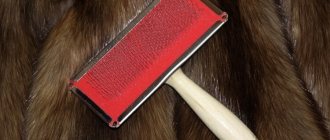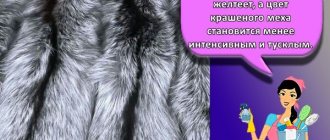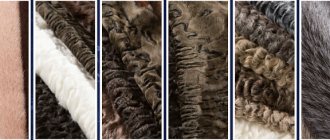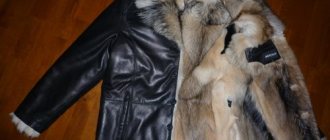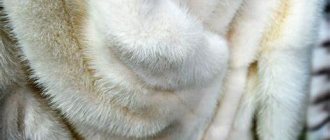It is best to purchase products for cleaning fur, natural or artificial, in advance so that you can prepare clothes for storage at the end of the season. Fur that has not undergone timely cleaning does not tolerate summer storage in a closet. In natural products, the core becomes rotten, dries out, becomes rough and bursts. If stored improperly, skin beetle larvae may begin to multiply in it, which infect animal skins during slaughter. Often the lining becomes moldy, which also requires special cleaning.
Synthetic pile becomes moldy from dirt and acquires an unpleasant odor. This can be avoided if the product is not only cleaned, but also dried in a well-ventilated place.
It is best to purchase products for cleaning fur, natural or artificial, in advance so that you can prepare clothes for storage at the end of the season
Important! Timely cleaning of clothes allows you to extend their service life.
Fur cleaning products can be purchased at a specialized store that sells lint products, or in household chemicals departments. If it is not possible to purchase a fur coat care kit, then they resort to home cleaning. In this case, you need to be careful not to spoil your favorite thing. If possible, then you need to contact professional organizations where there are fur cleaning products, and workers have special equipment and skills in caring for furs.
Timely cleaning of clothes allows you to extend their service life.
What do manufacturers offer?
Manufacturers began to produce cosmetics for pile products. They offer a variety of fur cleaning products to make it more convenient to care for winter clothes made from natural or artificial pile. Cosmetic products allow you to clean fur or products made from it at home, without resorting to dry cleaning services.
When choosing fur care products, you should purchase a natural product without aggressive chemical ingredients that can ruin the thing.
When choosing fur care products, you should purchase a natural product without aggressive chemical ingredients that can ruin the item. With the help of cosmetics you can:
- clean general dirt;
- remove food stains;
- remove grease;
- clean heavily soiled surfaces.
Manufacturers offer kits for comprehensive care of the product or individual products designed for high-quality fur processing.
Brush for cleaning fur products
Kits may include:
- cleaner;
- deep impact foam;
- fur restorer;
- special comb for lint;
- brush;
- oilcloth;
Rubber gloves are used when cleaning fur
- gloves;
- terry cloth;
- instructions.
Wet wipes are sold separately to help remove dirt from the pile while walking. This type of cleaning product allows you to take care of the fur and lining.
It is recommended to use a terry cloth when caring for a fur product.
To restore the natural structure of the inner layer and guard hairs, a reducing agent is used. Timely processing while actively wearing fur clothing can significantly extend the service life of the fur product.
Deep-impact foam is needed to remove recently stained stains. Each manufacturer comes up with its own formula, into which it introduces essential oils of plants and animal fat, so that the fur coat, after treatment, is protected from moths in the summer and shines in the winter. Such products are excellent for cleaning mink fur or other expensive fur coats.
Actions to take if a fur product is contaminated
First, you should find out that it is a moth that has settled in your fur coat. Since the caterpillars of this insect are always hidden and are located at the base of the pile, it is quite difficult to notice them with the naked eye. Having settled in thick fur, they weave small silk cocoons, which are replaced after each molt. The food for them is the lint; they do not touch the skin.
Signs of infection
The main sign of moths in your fur coat is individual bald spots. Empty areas indicate that the infestation is still minor. What other symptoms might there be?
- The fibers stick out in different directions, the fur is crumpled and looks sloppy.
- Hairs accumulate on the floor under the fur coat, which the caterpillar has cut off in order to move to the neighboring area.
- In places where the larvae move, the fur is crushed.
The fur coat will be most damaged where the caterpillar crawled. To saturate it, it needs a small amount of lint, and when moving, it simply cuts off the hairs that are in its path.
The surest sign of fur infection is a large accumulation of butterflies in the wardrobe and caterpillars, which are already visible to the naked eye. In this case, it is necessary to take decisive steps to destroy them.
How to save the product?
Now it’s time to figure out what to do if your fur coat is eaten by a moth. Everything here will depend on the scale of the damage caused.
- If the damage is numerous, then, unfortunately, the fur coat cannot be saved and the expensive item will simply have to be thrown away.
- Small flaws and a small number of narrow “paths” can be painted over with a marker matched to the color of the pile.
- Sometimes it’s easier to dye the fur coat itself to match the color of your skin.
- One small bald spot can be hidden in a fold by cutting out the damaged area and stitching the skin from the inside.
- If the bald spot is large, but only one, then it can be hidden under a brooch or an original patch.
- If there is damage only on the hem, but you don’t want to throw away the fur coat, then you can shorten it by contacting a tailor.
Cleaning with improvised means
If professional fur cleaning products are not available, then at home you can use old, time-tested, simple substances that will help clean the fur item from grease and dirt. Hot sand treatment is most often recommended. This type of processing is suitable for fur coats made from mole, beaver, and otter skins.
Hot sand is suitable for processing fur coats made from mole, beaver, and otter skins
To work, you will need clean, washed dry sand, heated on a baking sheet to a temperature of 40 degrees.
To carry out the procedure:
- the product should be laid out on a level place;
- contaminated areas are sprinkled with sand and rubbed clockwise with the palm of your hand;
- sand is removed as it becomes dirty and clean sand is added.
The product will be considered cleaned when the palm stops getting dirty.
Sand can be replaced for light fur with wet starch or talcum powder. They absorb grease and dirt well, but are very difficult to comb out. For dark mink fur, it is better to use semi-dry tea leaves.
Talc absorbs grease and dirt well, but is very difficult to comb out
You can use sawdust from deciduous trees if the item is too dirty. They are lightly moistened with pure gasoline, and after thorough cleaning they are taken outside to remove odors. This is how sheepskin is often cleaned.
Semolina can be used as a cleaning agent for white fur.
As a means for cleaning white fur, you can use bran, semolina or wheat. They need to be calcined, cooled to body temperature and applied to contaminated areas in the same way as sand.
You can use sawdust from deciduous trees if the item is too dirty.
If you need to restore the whiteness of a white fur coat, you can treat the pile with hydrogen peroxide after cleaning and drying. Peroxide will not harm the guard hair or fluff; it discolors the yellowness.
Peroxide will not harm the guard hair or fluff; it discolors the yellowness
Give your fur coat a fresh look at home
If you don’t want to take your mink coat to the dry cleaner, you can clean it at home. Need to remember:
- It is not recommended to wash mink, since this causes it to decrease in size and also deteriorate the quality of the pile. It can fall out, become brittle, hard, and lose its plasticity. Therefore, when cleaning the mink, it is better not to expose the mink to strong water;
- When cleaning, long piles should be combed according to the growth of the villi; cut piles should be combed against them.
Potato starch, flour, talc effectively and quickly remove dirt from white or blue mink without harming the fibers. To clean, place the fur coat on a flat surface, then sprinkle it with powder, gently rub it with your hands and shake it off. If the flour becomes dark, repeat the procedure.
You can also leave the starch for a day to absorb the dirt. A vacuum cleaner will get rid of flour residues on your fur coat.
The next cleaning method is to remove dirt with wood dust. To do this, you need to lay the product out on the table and sprinkle the stains with very fine, dust-like wood shavings. Then leave the fur coat overnight in a well-ventilated area. In the morning, remove wood dust with a vacuum cleaner. Using this method, you need to work in protective equipment - a mask and a respirator.
Useful tips
If you properly care for natural fur coats and collars, you will have to clean them infrequently:
- Fur products are afraid of getting wet. It is recommended to wear natural hats, fur coats and collars in cold but dry weather, and not in snow and rain.
- If the pile does get wet, then it should be dried immediately in warm conditions, straightened out.
- Natural fur has a very delicate structure. Even if it needs to be cleaned, this should be done with light movements; you should not aggressively rub the pile with sponges and brushes.
- Fur clothing turns yellow and loses its shine from close contact with other things. Fur coats and hats should be stored in a spacious closet, making sure that they do not come into contact with adjacent clothing.
In spring and summer, fur coats and hats need to be taken out of the closet from time to time and ventilated, this will avoid the occurrence of an unpleasant odor.
For better preservation, fur clothing should be regularly ventilated and cleaned using dry methods.
Advice! At the end of the season, it is useful to treat fur items with specialized preventative agents - this will protect them from dust and moths during storage.
Clean the collar from dust and dirt
A silver fox fur collar is subject to more contamination than a solid fur product, because it is often used when finishing demi-season outerwear, which, unlike a fur coat, is worn in any bad weather.
To rid the collar of street dust and dirt, you need to follow this algorithm:
- spread a wet sheet on a horizontal surface;
- place the collar on it with the fur down;
- carefully knock out all possible dust from the product, which will ultimately remain on the fabric;
- shake the collar and comb it.
To remove various contaminants from the collar or rid it of yellowness, you need to use one of the above products.
Odor removal
Mink coat easily absorbs aromas. A vinyl clothing cover and freshly ground coffee will help get rid of the odors of smoke, perfume, and mold. Clean according to the following scheme:
- First, hang the mink in a vinyl garment cover.
- Place a container of freshly ground coffee at the bottom of the case.
- Zip the cover and leave it hanging so that the fur coat absorbs the aroma of coffee.
After a day, you need to check whether the unpleasant odor has disappeared from the fur. If not, you can mix the coffee powder and leave the fur coat hanging next to the coffee for another day. To prevent the mink from smelling like coffee after the procedure, it should be left hanging in a well-ventilated area for one day.
Caring for wet fur
If rain or snow gets your fur coat wet, special care is required. Under no circumstances should you rub or try to wipe away moisture from the fur with a towel. You need to very carefully shake off the moisture from the product. After this, hang it in a cool (never warm!) and dry place. A place protected from weather conditions in the fresh air is best suited for this. If this is not possible, you can hang the fur coat near an open window. In this state, you need to let the product hang for one or two days.
How to get rid of stains
To clean small stains from white or blue mink, mix one part pure rubbing alcohol with one part water. Then dampen a clean white cloth with this mixture and rub the stain until it disappears. Do not rinse after cleaning. After removing the stain, you need to leave the fur coat in a well-ventilated area until the water and alcohol completely evaporate from the fur.
You can remove grease stains, sweat residues, or bleach white mink using ammonia. This can be done in two ways:
- Dilute ammonia in 200 g of water and add a couple of drops of liquid soap. Soak a white cloth in the mixture and clean the lint.
- In 200 g of water, stir 20 g of salt and 0.5 tsp. ammonia. Soak a white cloth in the solution, rub it over the product, and leave for a few minutes. Then, pressing slightly on the fur, remove the dirt.
Another method for cleaning mink coats is to use table vinegar. It must be mixed in equal parts with ammonia or simple alcohol, moisten the cloth and clean. At the end of the procedure, to give the pile shine, wipe the fur with a cotton swab dipped in 5% vinegar.
Recommendations for care and use
To prevent contamination and prolong the life of your favorite things, you must follow these rules:
- Store in a spacious place so that the silver fox does not wrinkle.
- Where things are stored, use insect and parasite protection products, such as plates and tablets. Avoid direct contact of chemicals with the fur of the silver fox.
- Before packing the product, clean and dry thoroughly.
- For long-term storage, the fur coat is hung on hangers, the hat is put in a fabric bag and placed in a spacious compartment.
- To protect the fur from moths, all products are packaged in covers, bags, and boxes.
- Avoid moisture, rainy weather, snow. Otherwise, dry naturally and comb the pile.
- Protect fur from interaction with high temperatures.
- It is not recommended to carry the bag on your shoulders. Due to frequent friction, the pile wears out.
- Avoid riding on public transport.
General rules
To determine whether clothes need cleaning, hang the item on a hanger and blow cold air through it. If the fibers do not stick together, but scatter freely, the fur is clean.
To clean silver fox fur, you should follow the general rules:
- Do not wash fur.
- Before cleaning, knock out dust and remove dirt particles.
- First prepare a flat, clean surface on which to place the product. Avoid getting liquid on the inside.
- You should test the cleaning method on a less visible area.
- In order not to damage the fox fur, you need to avoid strong friction.
- When brushing, movements are directed according to the growth of the coat.
- Fur should be dried in a ventilated area. It may take several days. Protect from sunlight.
- It is prohibited to use artificial heat sources to dry silver fox. The pile will lose its softness and turn yellow.
- Do not pet the silver fox. Even from the reverse side you can harm the fur.
- Do not use washing powders, bleaches, or aggressive substances.
Advice! If the leather base has become rough, dissolve glycerin in warm water and rub the inside, crush it a little, and stretch it. Remove any remaining glycerin and send the item to dry.
Folk remedies that are prohibited to use
There are often recommendations from folk methods that advise using products such as starch, semolina, flour, wheat bran, sawdust, and gasoline to clean silver fox fur.
Experience shows that these remedies are not only ineffective, but also unsafe.
- Starch, talc, flour, bran, sawdust absorb greasy dirt well, but they are not able to bleach fur and have no effect on dry dirt; at the same time, particles of these substances will inevitably remain in the underfur and under the lining, which will significantly increase the risk of moths.
- Gasoline can help in cleaning light fur only if it is a purified substance purchased at a hardware store, otherwise the effect will be the opposite, the silver fox will turn even more yellow. It is also worth considering other unpleasant aspects of working with gasoline, such as flammability and a pungent odor, which require compliance with safety regulations.
Important! Sawdust from coniferous trees can hopelessly ruin fur with the resins they contain.
Cleaning light fur
In order to clean light natural fur, you can use the following methods:
- Starch is the best of all cleaning agents for white fur coats, collars or hats made of natural fur. Having generously poured it directly onto the fur, the product is gently crushed until the powder has collected all the dust. Then the item is shaken and combed. The procedure is repeated a couple more times.
- Wheat or rye bran, semolina or potato flour are also suitable for cleaning white fur. Sprinkle generously with one of the indicated adsorbents and gently rub in your palms along with the fur. Then the product is shaken and cleaned with a soft brush.
- To prevent white fur from turning yellow, it is wiped with a solution of hydrogen peroxide. To do this, take a large spoon of peroxide and stir it in a liter of water. Gently blot the fibers, then dry. It is recommended to wipe fur that has turned yellow over time with a more concentrated solution of hydrogen peroxide.
- To remove a greasy stain on a white fur item, dissolve a teaspoon of ammonia and 3 small spoons of table salt in half a liter of water.

